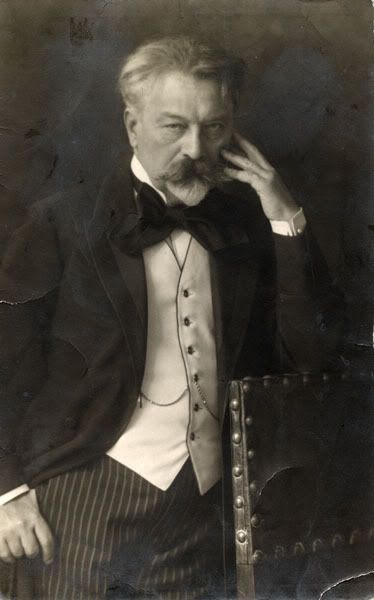Sator
Distinguished Member
- Joined
- Apr 29, 2006
- Messages
- 3,083
- Reaction score
- 39
My guidebook laments that Vienna lacks large department stores, yet that precisely turns out to the greatest strength of Vienna for those of us in search of old world luxury, repeatedly disappointed by the reiteration of the same generic brands in every large city. Vienna excels in old world luxuries from family owned boutiques, something yet to be killed off by predatory department stores. First stop for me was Knize, situated right in the middle of Graben:
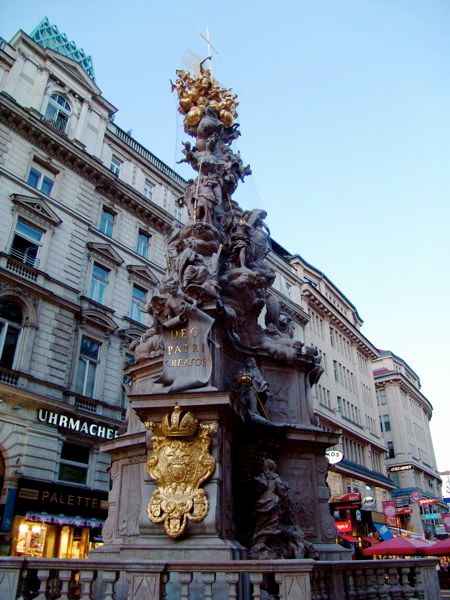 It turns out the fa̤ade of the store was designed by none other than Adolf Loos, the famous Viennese turn of the century architect Рpictured here reassuringly wearing his silk faced frock coat with fancy covered buttons; stiff, detachable stand up collar, with pinned dress cravat; lapelless DB waistcoat; and Cashmere striped morning trousers:
It turns out the fa̤ade of the store was designed by none other than Adolf Loos, the famous Viennese turn of the century architect Рpictured here reassuringly wearing his silk faced frock coat with fancy covered buttons; stiff, detachable stand up collar, with pinned dress cravat; lapelless DB waistcoat; and Cashmere striped morning trousers:
 The store is definitely worth visiting as much for its architectural value as for the clothes.
The store is definitely worth visiting as much for its architectural value as for the clothes.
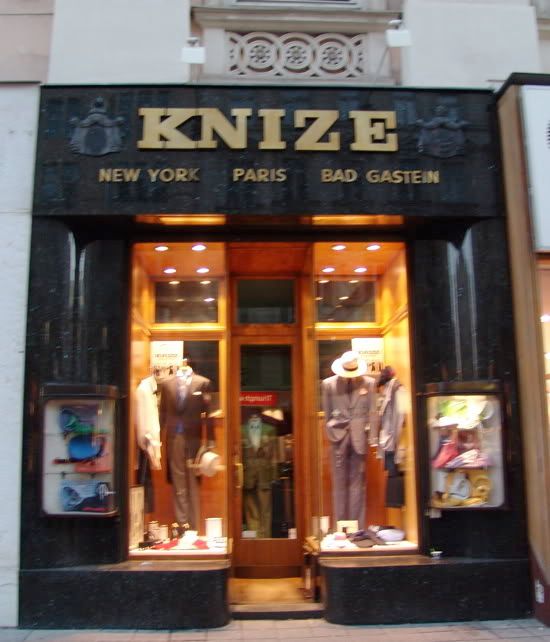
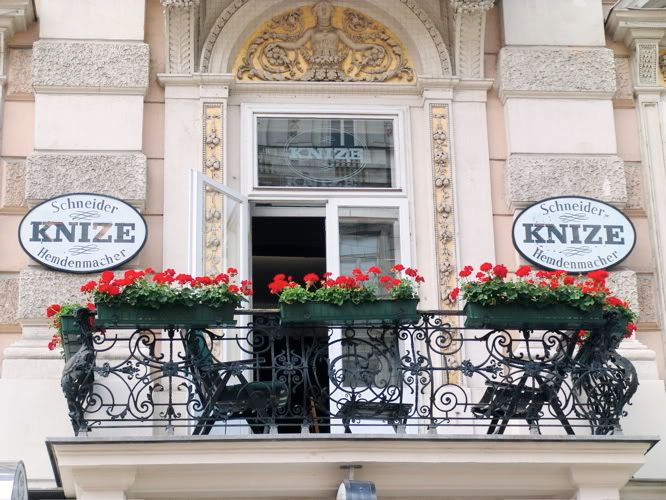 I ended up buying a couple of ties there, which turned out to be both reasonable value and quite nice. My visit was too short to permit me to even consider bespoke so I did not enquire about costs. Curiously, I noted that the assistants always pronounce the store name as “K’nee-djar” rather than “K’nee-tzi” as one would normally expect in pronouncing German. The one disappointment would be that their third generation bespoke operation seemed to be rather overshadowed by the unfortunate over prominence of Kiton, Brioni and Cucinelli RTW everywhere. They even had a range of Knize range RTW shoes. Although not unattractive, they were nothing exceptional and were presumably Hungarian made, although almost certainly not by Vass. Of course, the store window display was worth commenting on:
I ended up buying a couple of ties there, which turned out to be both reasonable value and quite nice. My visit was too short to permit me to even consider bespoke so I did not enquire about costs. Curiously, I noted that the assistants always pronounce the store name as “K’nee-djar” rather than “K’nee-tzi” as one would normally expect in pronouncing German. The one disappointment would be that their third generation bespoke operation seemed to be rather overshadowed by the unfortunate over prominence of Kiton, Brioni and Cucinelli RTW everywhere. They even had a range of Knize range RTW shoes. Although not unattractive, they were nothing exceptional and were presumably Hungarian made, although almost certainly not by Vass. Of course, the store window display was worth commenting on:
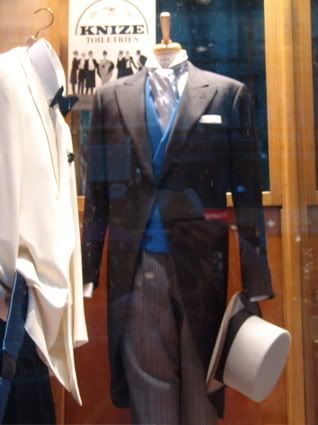 Morning dress of course. There was a little poster in the window display too:
Morning dress of course. There was a little poster in the window display too:
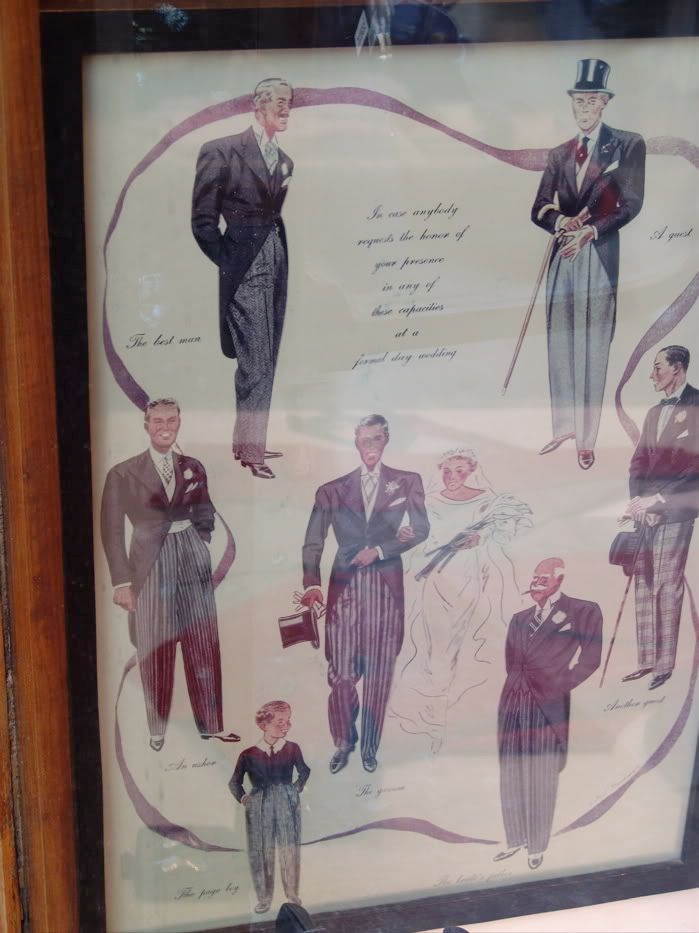 Indeed, morning dress seemed to pop up everywhere around the city.
Indeed, morning dress seemed to pop up everywhere around the city.

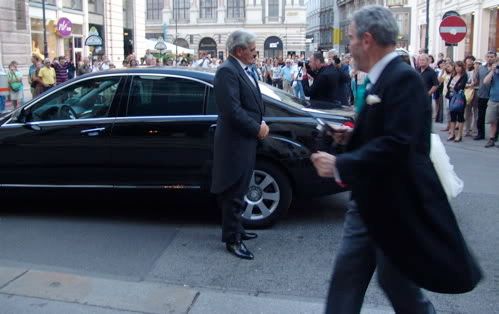 Not all flawlessly executed, I know, but even at its worst, still far better than the wretched “tux” in broad daylight. To see those, you had to go into the coffee houses, where the waiters wore some form of dinner jacket as a form of livery. So to wear one at a wedding, one would doubtless invite calls of “Herr Ober! – fetch me a glass of wine” The Viennese Kaffeehäuser are indeed rightly famous, and it is definitely worthwhile doing a round of the best known places, to try out their meals, admire their architecture – as well as to drink coffee. My favourite turned out to be Sigmund Freud’s old haunt, Cafe Landtmann right across the road from the front of the university.
Not all flawlessly executed, I know, but even at its worst, still far better than the wretched “tux” in broad daylight. To see those, you had to go into the coffee houses, where the waiters wore some form of dinner jacket as a form of livery. So to wear one at a wedding, one would doubtless invite calls of “Herr Ober! – fetch me a glass of wine” The Viennese Kaffeehäuser are indeed rightly famous, and it is definitely worthwhile doing a round of the best known places, to try out their meals, admire their architecture – as well as to drink coffee. My favourite turned out to be Sigmund Freud’s old haunt, Cafe Landtmann right across the road from the front of the university.
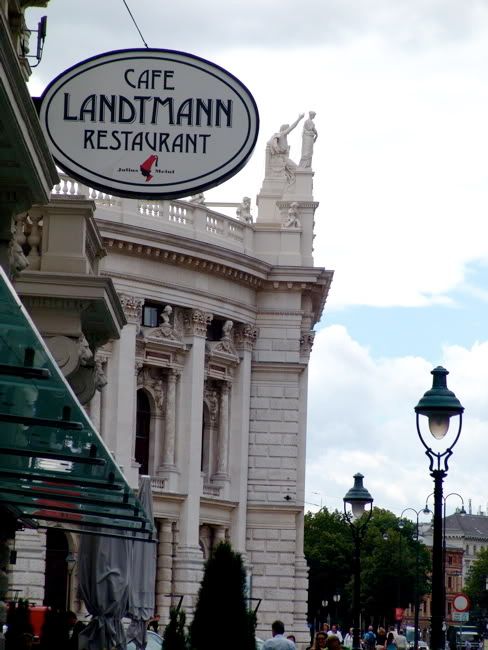
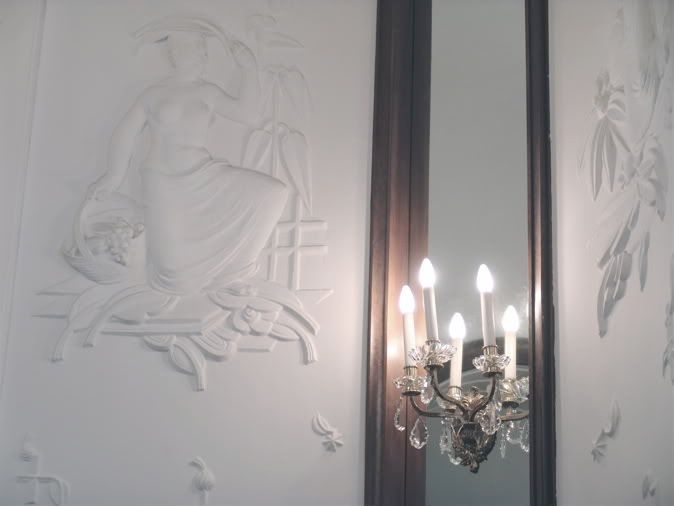 Freud’s old house is a couple of tram stops away, and, as I imagine he would have held tenure at the university, the coffee house would have provided a convenient meeting point for academics. Between lectures and seeing clients, I could imagine him sitting there discoursing with those initiated into his intellectual circle. The art deco styling inside is beautifully preserved, and a pleasure to behold. I thought their Einspänner to perhaps be the finest in town. Here is Freud’s old hat, which probably did a bit of hanging at CafÃ
Freud’s old house is a couple of tram stops away, and, as I imagine he would have held tenure at the university, the coffee house would have provided a convenient meeting point for academics. Between lectures and seeing clients, I could imagine him sitting there discoursing with those initiated into his intellectual circle. The art deco styling inside is beautifully preserved, and a pleasure to behold. I thought their Einspänner to perhaps be the finest in town. Here is Freud’s old hat, which probably did a bit of hanging at CafÃ
 Landtmann as well:
Landtmann as well:
 I wonder who made it, for anyone who knows hats will see that it has been very nicely blocked with a beautiful felt which has weathered the decades very well. Coffee. Now, there’s a topic all of its own. I couldn’t help but cringe at the way the American and Australian tourists always order a “cappuccino”. Little do they know that, although offered by coffee houses (for the tourists no doubt), more authentically Viennese are the Melange, the Einspänner or Slagobers. Turkish styled coffe is also traditionally served. The coffee culture is quite distinct in character from the Italian one. Also worthy of mention is the fact that the food at the best coffee houses is also excellent. My favourite lunchtime dish by the end turned out to be a good Tafelspitz – silver side of beef, cooked with vegetables and served with applesauce, garnished with chopped radish, along with a second spinach sauce along and some cream. The Emperor Franz Joseph was said to have eaten it every day for lunch. Again, CafÃ
I wonder who made it, for anyone who knows hats will see that it has been very nicely blocked with a beautiful felt which has weathered the decades very well. Coffee. Now, there’s a topic all of its own. I couldn’t help but cringe at the way the American and Australian tourists always order a “cappuccino”. Little do they know that, although offered by coffee houses (for the tourists no doubt), more authentically Viennese are the Melange, the Einspänner or Slagobers. Turkish styled coffe is also traditionally served. The coffee culture is quite distinct in character from the Italian one. Also worthy of mention is the fact that the food at the best coffee houses is also excellent. My favourite lunchtime dish by the end turned out to be a good Tafelspitz – silver side of beef, cooked with vegetables and served with applesauce, garnished with chopped radish, along with a second spinach sauce along and some cream. The Emperor Franz Joseph was said to have eaten it every day for lunch. Again, CafÃ
 Landtmann did the best Tafelspitz in town bar none. Having eaten out in Italy and Paris, I can say the food in Vienna is some of the finest in Europe. Also do check out the ham sandwiches at the Black Camel – Zum Schwarzen Kameel. However, perhaps what Vienna is best known for in the sartorial world is its bespoke shoemakers. First and foremost amongst these is Rudolph Scheer und Söhne. Founded in 1816, and now run by the seventh generation, it must surely be the oldest bespoke bootmaking business in existence. It is extraordinary to think that John Lobb wasn’t even born when the store was founded. Lobb was born only in 1828, and founded his store in St James only much later in the 19th century after a stint in Sydney, Australia during the Gold Rush. Even today Scheer proudly carries its Royal Warrant held during the days of the Austrian monarchy. “K.u.K” – Kaiserlich und Königlich (Royal and Imperial) – are the letters adorning the front of the store, along with the coat of arms of the Habsburg monarchy with its characteristic double headed eagle:
Landtmann did the best Tafelspitz in town bar none. Having eaten out in Italy and Paris, I can say the food in Vienna is some of the finest in Europe. Also do check out the ham sandwiches at the Black Camel – Zum Schwarzen Kameel. However, perhaps what Vienna is best known for in the sartorial world is its bespoke shoemakers. First and foremost amongst these is Rudolph Scheer und Söhne. Founded in 1816, and now run by the seventh generation, it must surely be the oldest bespoke bootmaking business in existence. It is extraordinary to think that John Lobb wasn’t even born when the store was founded. Lobb was born only in 1828, and founded his store in St James only much later in the 19th century after a stint in Sydney, Australia during the Gold Rush. Even today Scheer proudly carries its Royal Warrant held during the days of the Austrian monarchy. “K.u.K” – Kaiserlich und Königlich (Royal and Imperial) – are the letters adorning the front of the store, along with the coat of arms of the Habsburg monarchy with its characteristic double headed eagle:
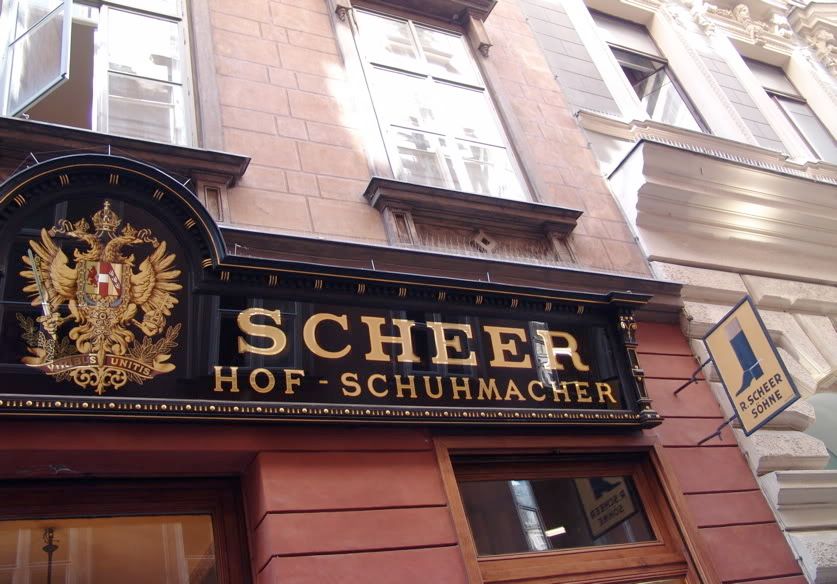 The same coat of arms adorns the top of the Hofburg palace:
The same coat of arms adorns the top of the Hofburg palace:
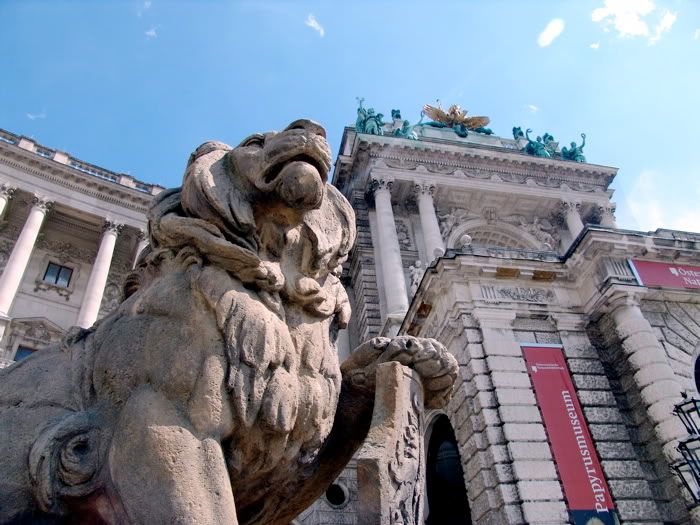
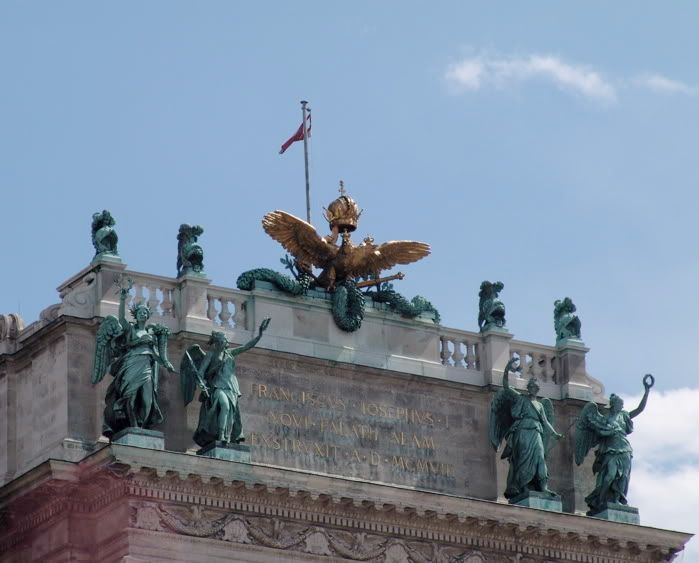 And here it is once again, on the top left hand corner of this famous portrait of Maximilian I, Holy Roman Emperor painted by Albrecht Dürer:
And here it is once again, on the top left hand corner of this famous portrait of Maximilian I, Holy Roman Emperor painted by Albrecht Dürer:
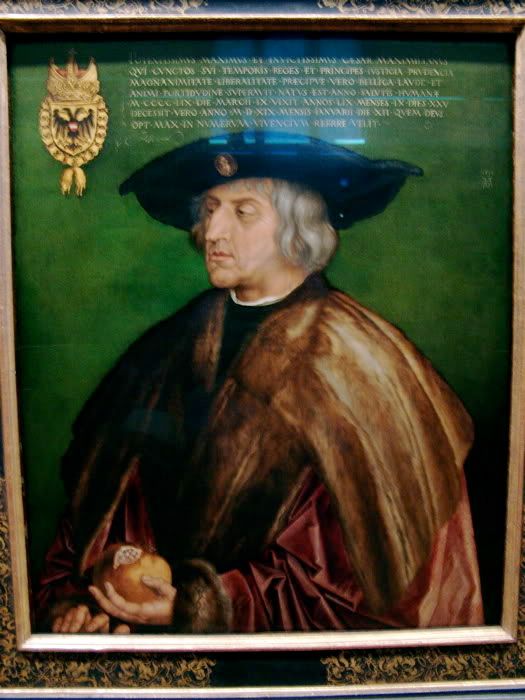 On entering the Scheer store, the inside resembles the John Lobb store in St James in many ways. Old wooden cabinets are full of old button boots and Wellingtons. They even still have the lasts for Emperor Franz Joseph and Kaiser Wilhelm. I enquired about putting in an order but they themselves were hardly encouraging: “we don’t need any more customers”. It takes at least a year before the trial shoes are ready and at least another year after that before the final shoes are finished. Overall it could take about two to three years before they are complete. The minimum total cost for the first pair – 2200 Euros. Was I tempted? Hell yes, and I thought about it quite a while but in the end didn’t. One day I will. Anyway, here are a couple of examples of their work from the window display:
On entering the Scheer store, the inside resembles the John Lobb store in St James in many ways. Old wooden cabinets are full of old button boots and Wellingtons. They even still have the lasts for Emperor Franz Joseph and Kaiser Wilhelm. I enquired about putting in an order but they themselves were hardly encouraging: “we don’t need any more customers”. It takes at least a year before the trial shoes are ready and at least another year after that before the final shoes are finished. Overall it could take about two to three years before they are complete. The minimum total cost for the first pair – 2200 Euros. Was I tempted? Hell yes, and I thought about it quite a while but in the end didn’t. One day I will. Anyway, here are a couple of examples of their work from the window display:
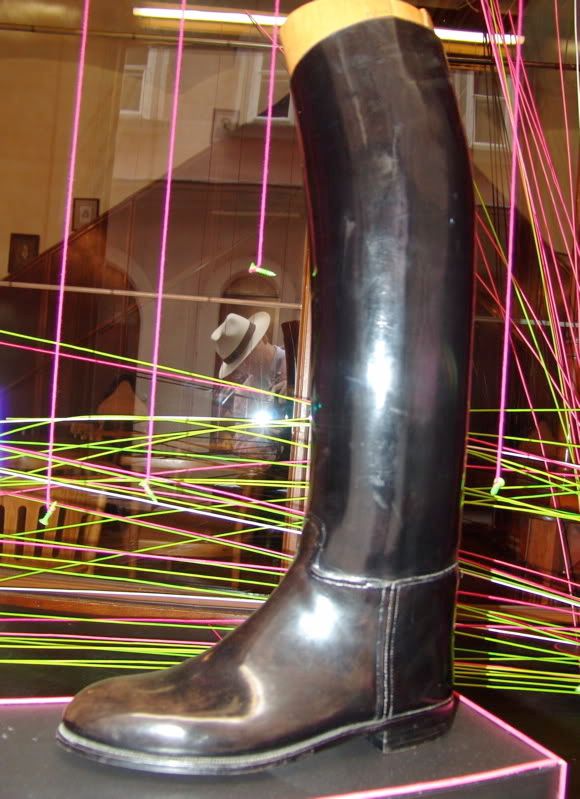
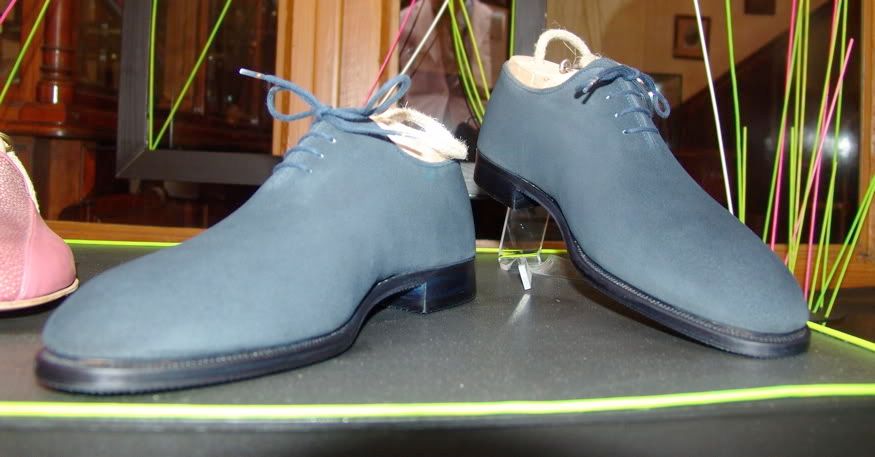
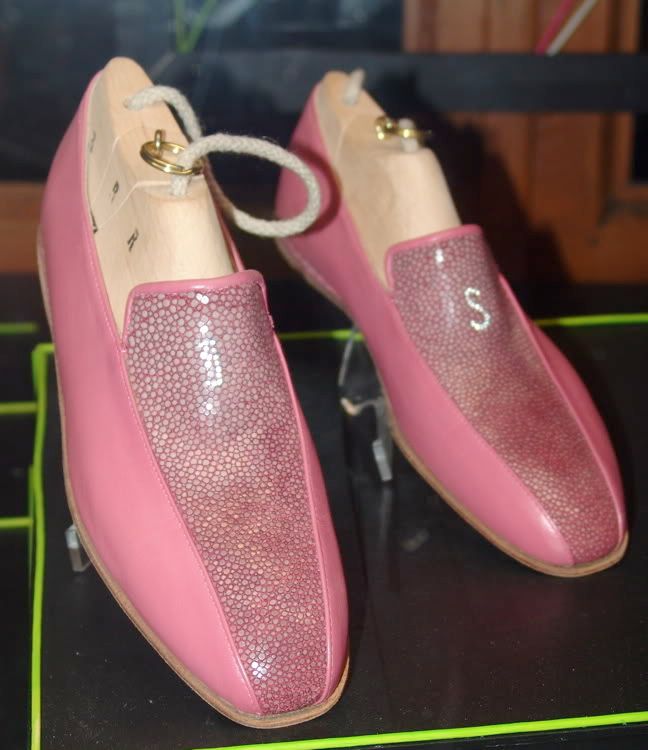 And something from a catalogue:
And something from a catalogue:
 For more pictures see: http://scheer.at/ I wish in retrospect that I had asked to inspect a sample of their work, so I could carefully see what their workmanship is really like first hand. Fortunately, other shoemakers in town charge more reasonable prices. The Viennese have a more formal system of apprenticeship than the English or Germans do, and it takes some time to acquire the formal qualification required to call oneself a shoemaker. As a consequence there seems to a wonderful proliferation of shoemakers all over the city, although I also understand some of these just take orders for some Hungarian workshop after being trained to take measurements. Still, Vienna seems a veritable El Dorado of bespoke shoemaking. I particularly enjoyed the style of shoes by Balint with their consistently elegant lasts. I walked in unannounced to find Herr Balint busy with his lastmaking. He was at his machine with a mask on and asked his wife to show me around. Prices start here at 1990 Euros. They charge a little more for welted shoes than they do for wood pegged (holzgenagelt) shoes, and a bit more still for Goyserer (zwiegenäht) welted shoes. Everywhere it seemed, most makers appear to somewhat prefer the holzgenagelt technique.
For more pictures see: http://scheer.at/ I wish in retrospect that I had asked to inspect a sample of their work, so I could carefully see what their workmanship is really like first hand. Fortunately, other shoemakers in town charge more reasonable prices. The Viennese have a more formal system of apprenticeship than the English or Germans do, and it takes some time to acquire the formal qualification required to call oneself a shoemaker. As a consequence there seems to a wonderful proliferation of shoemakers all over the city, although I also understand some of these just take orders for some Hungarian workshop after being trained to take measurements. Still, Vienna seems a veritable El Dorado of bespoke shoemaking. I particularly enjoyed the style of shoes by Balint with their consistently elegant lasts. I walked in unannounced to find Herr Balint busy with his lastmaking. He was at his machine with a mask on and asked his wife to show me around. Prices start here at 1990 Euros. They charge a little more for welted shoes than they do for wood pegged (holzgenagelt) shoes, and a bit more still for Goyserer (zwiegenäht) welted shoes. Everywhere it seemed, most makers appear to somewhat prefer the holzgenagelt technique.

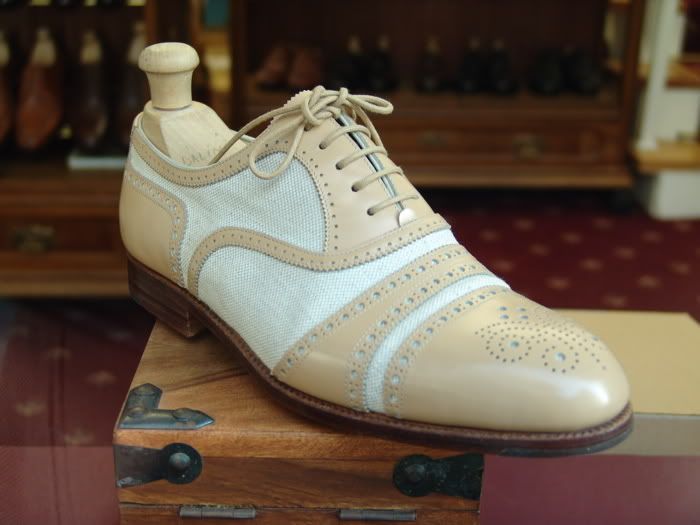
 Curiously, Balint does not believe in trial shoes. They don’t feel they are useful and will make a new pair up free of charge if the first pair fail to fit. Even more reasonably priced was Materna at around 1300 Euros for holzgenagelt shoes. However, all subsequent shoes also cost just as much and a last making fee is not deducted. Herr Materna explained that he was a third generation shoemaker. He too felt that trial shoes were a waste of time. You can make them, he said, but the “shoes still don’t fit anyway”, as the fit of trial shoe and the real thing turn out to be quite different. He is also happy to measure the customer up and then ship the finished shoes out, although he did prefer that for the first pair that the customer picked them up in person, so any adjustments could be made in person. Curiously, he says he has quite a few customers in Australia already. The house style here is much more naturally round and less elongated than from other shoemakers. More 202 last than 82 or 888, if that makes sense:
Curiously, Balint does not believe in trial shoes. They don’t feel they are useful and will make a new pair up free of charge if the first pair fail to fit. Even more reasonably priced was Materna at around 1300 Euros for holzgenagelt shoes. However, all subsequent shoes also cost just as much and a last making fee is not deducted. Herr Materna explained that he was a third generation shoemaker. He too felt that trial shoes were a waste of time. You can make them, he said, but the “shoes still don’t fit anyway”, as the fit of trial shoe and the real thing turn out to be quite different. He is also happy to measure the customer up and then ship the finished shoes out, although he did prefer that for the first pair that the customer picked them up in person, so any adjustments could be made in person. Curiously, he says he has quite a few customers in Australia already. The house style here is much more naturally round and less elongated than from other shoemakers. More 202 last than 82 or 888, if that makes sense:
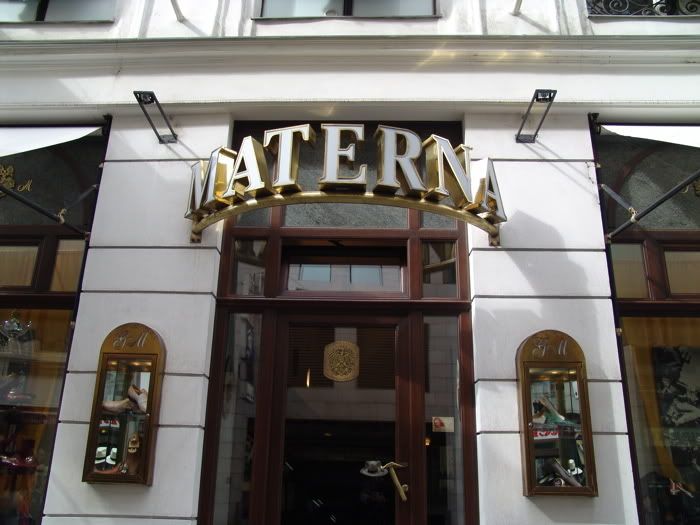
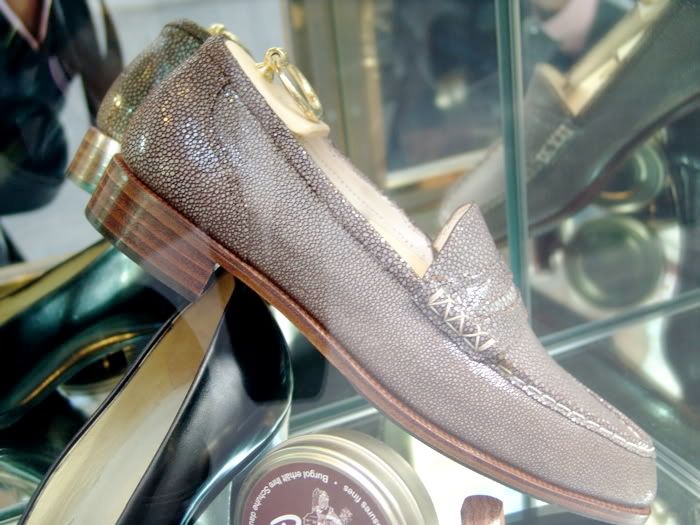
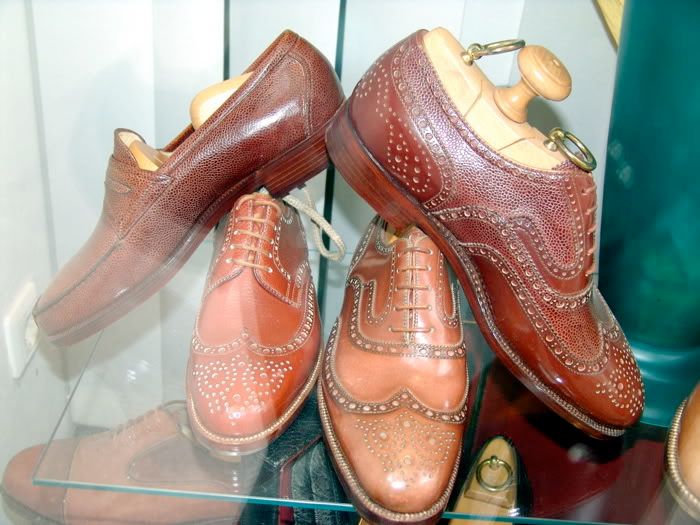 Prominent amongst the display shoes in store are stingray shoes: “it’s so tough, you could play football in those”, Herr Materna explained. Not coincidentally perhaps, I notice this pair in the window display outside:
Prominent amongst the display shoes in store are stingray shoes: “it’s so tough, you could play football in those”, Herr Materna explained. Not coincidentally perhaps, I notice this pair in the window display outside:
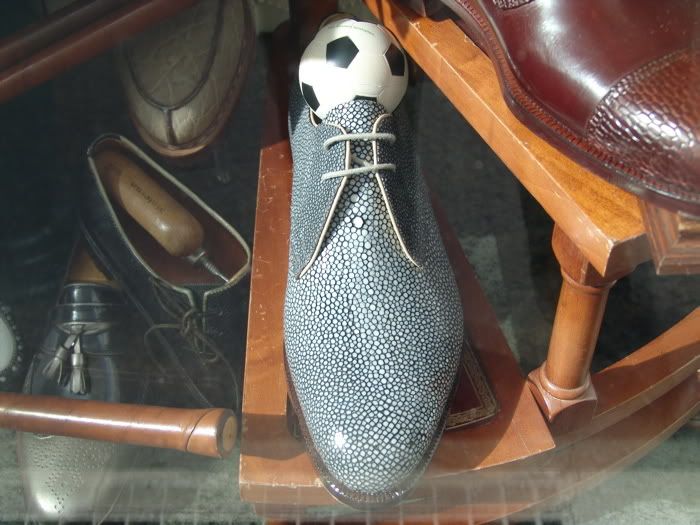 In my excitement however, I forgot to take any photos whatsoever at Maftei where I did place my order. Hopefully, it will be ready in a few weeks time. Frau Maftei-Barbu measured me up taking detailed measurements of each foot, and at the trial fitting a little over a week later all seemed well. At under a thousand Euros a pair, this will probably not be my last order either. Initially, I gravitated out of habit towards welted shoes but was steered gently towards holzgenagelt shoes, which are much less time consuming to make. Also at Maftei, as well as at other shoemakers, it was explained that a bevelled waist was regarded as something traditionally not done on a man’s shoe. They would all show me examples of women’s bespoke shoes made with a bevelled waist but to do that on a man’s shoe, they all agreed, was something universally regarded as being rather English. Incidentally, for those interested in bespoke shoes for their partners, the holzgenagelt technique allows a thin sole to be closely trimmed to the edge of the shoe as with glued fashion shoes, while maintaining all the robustness of welted shoes. Here is one example from Materna:
In my excitement however, I forgot to take any photos whatsoever at Maftei where I did place my order. Hopefully, it will be ready in a few weeks time. Frau Maftei-Barbu measured me up taking detailed measurements of each foot, and at the trial fitting a little over a week later all seemed well. At under a thousand Euros a pair, this will probably not be my last order either. Initially, I gravitated out of habit towards welted shoes but was steered gently towards holzgenagelt shoes, which are much less time consuming to make. Also at Maftei, as well as at other shoemakers, it was explained that a bevelled waist was regarded as something traditionally not done on a man’s shoe. They would all show me examples of women’s bespoke shoes made with a bevelled waist but to do that on a man’s shoe, they all agreed, was something universally regarded as being rather English. Incidentally, for those interested in bespoke shoes for their partners, the holzgenagelt technique allows a thin sole to be closely trimmed to the edge of the shoe as with glued fashion shoes, while maintaining all the robustness of welted shoes. Here is one example from Materna:
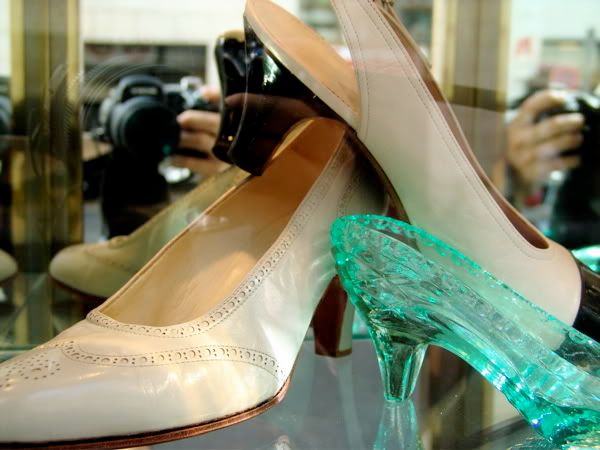 One place perhaps worth checking out for those interested, is this bespoke shirtmaker:
One place perhaps worth checking out for those interested, is this bespoke shirtmaker:
 This store also offers some fine leatherware, made in Vienna by Robert Horn:
This store also offers some fine leatherware, made in Vienna by Robert Horn:
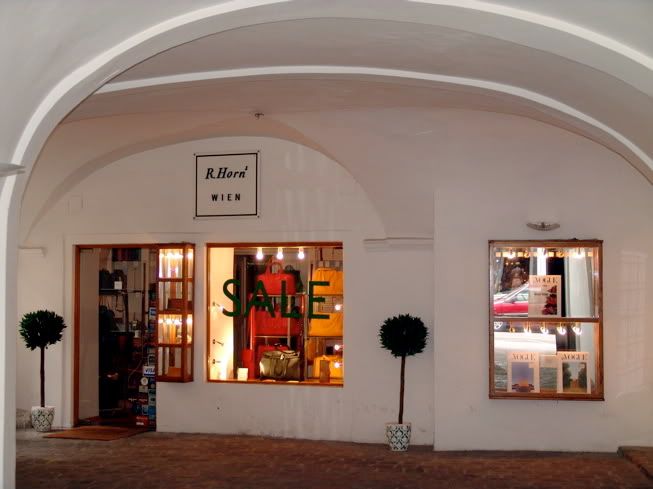 Horn claims that he is unable to improve on the design of a briefcase carried by Metternich at the Congress of Vienna. To end this little sartorial adventure, here are a few of Vienna’s favourite sons and adopted sons. Firstly, Wolfgang Amadeus:
Horn claims that he is unable to improve on the design of a briefcase carried by Metternich at the Congress of Vienna. To end this little sartorial adventure, here are a few of Vienna’s favourite sons and adopted sons. Firstly, Wolfgang Amadeus:
 A rarely seen portrait of the 13 year old Beethoven:
A rarely seen portrait of the 13 year old Beethoven:
 Johann Strauss:
Johann Strauss:
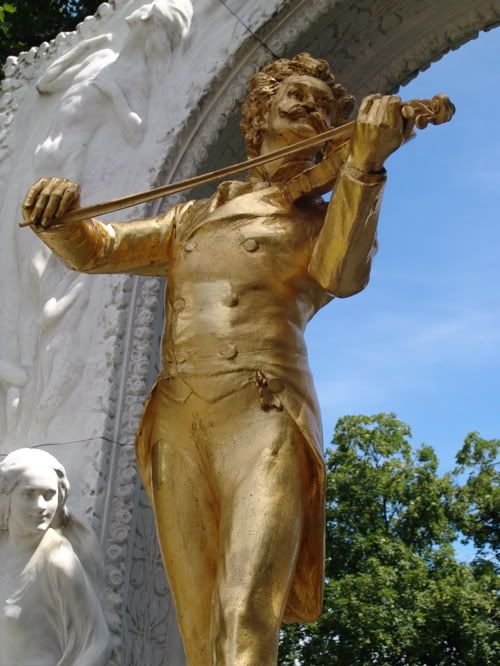 Note that his evening dress coat really does button up and probably lacks side bodies, as was typical around the mid-century. Also worthy of remark is the fact that mid century fashion journals mention that it is actually desirable for half an inch of the waistcoat to show beneath the cut away front of the dress coat. Evidently, the act of raising the arms to play the violin has caused a bit more than that to show. Theodor Billroth:
Note that his evening dress coat really does button up and probably lacks side bodies, as was typical around the mid-century. Also worthy of remark is the fact that mid century fashion journals mention that it is actually desirable for half an inch of the waistcoat to show beneath the cut away front of the dress coat. Evidently, the act of raising the arms to play the violin has caused a bit more than that to show. Theodor Billroth:
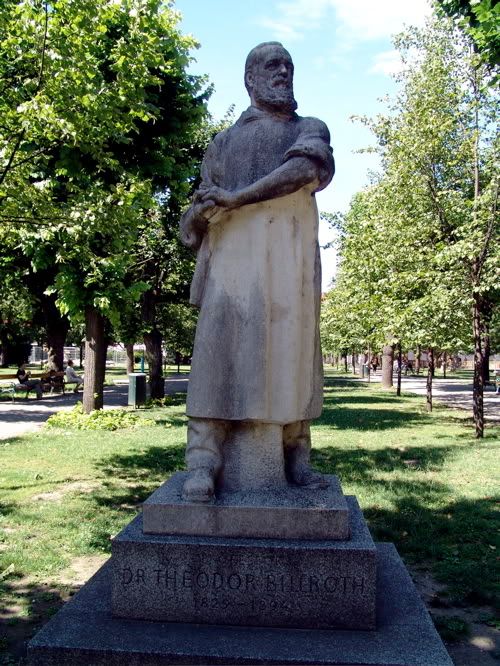 We take it for granted that surgeons wear theatre gowns, but it was a radical innovation introduced by Billroth. Sigmund Freud:
We take it for granted that surgeons wear theatre gowns, but it was a radical innovation introduced by Billroth. Sigmund Freud:
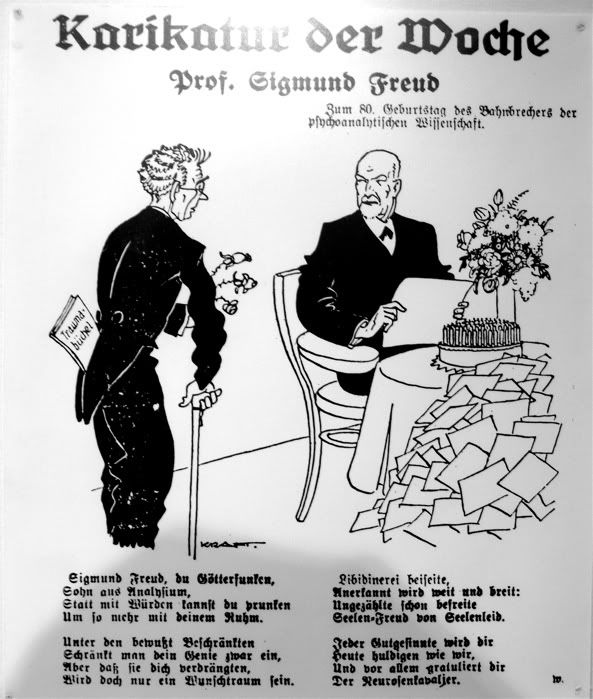 The humorous parody of Schiller’s Ode to Joy will be apparent to German readers, hailing Freud as “thou Son of Analysium” (“Daughter of Elysium” are the words in Schiller’s Ode). All in all, Vienna is a splendid place that I greatly look forward to visiting again in the near future.
The humorous parody of Schiller’s Ode to Joy will be apparent to German readers, hailing Freud as “thou Son of Analysium” (“Daughter of Elysium” are the words in Schiller’s Ode). All in all, Vienna is a splendid place that I greatly look forward to visiting again in the near future.






































